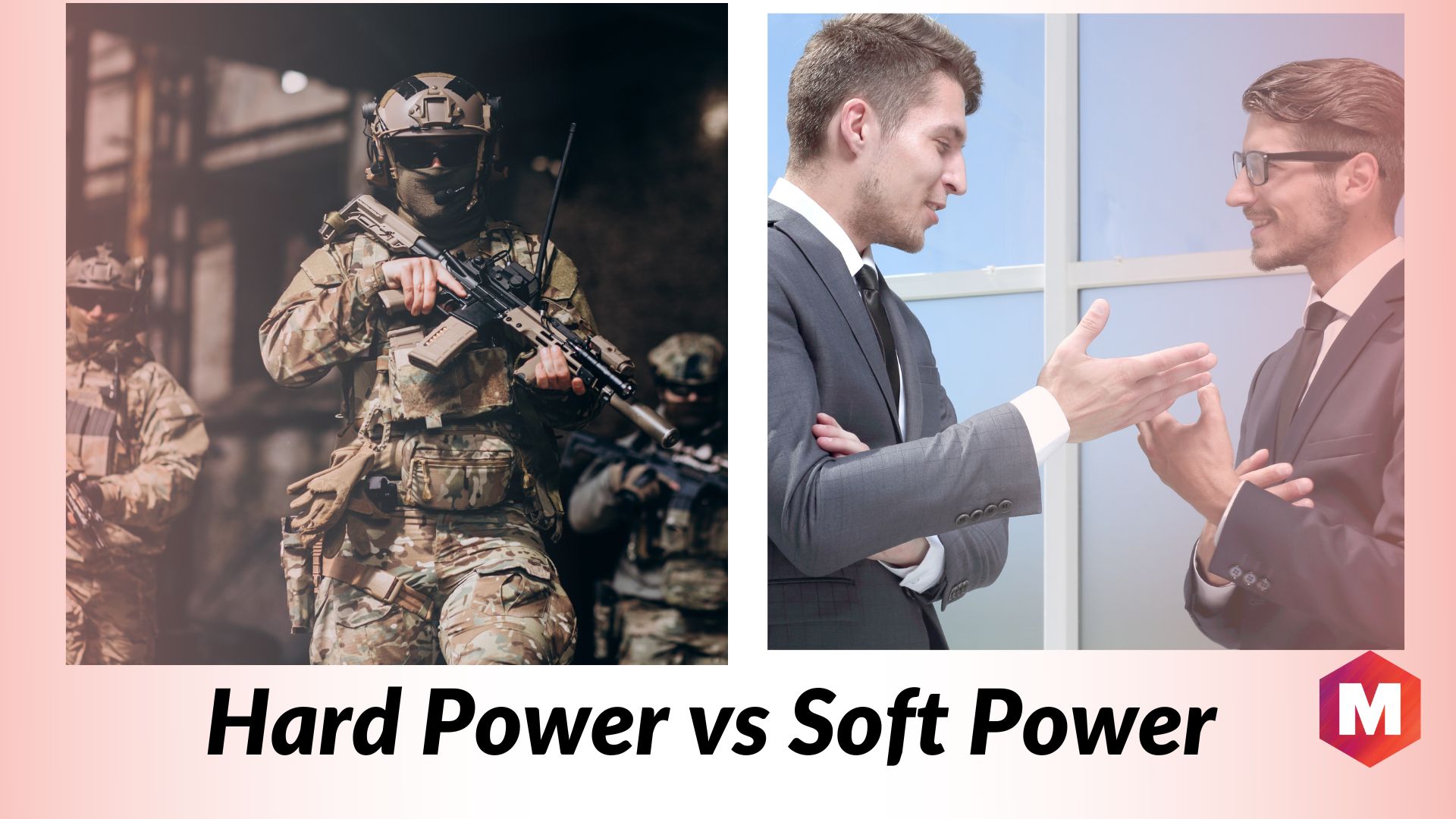Table of Contents
What is Hard Power?
Hard power is the “ability to use military or economic coercion to influence the behavior of another state, group, political body or individual.”
Hard power is often used in foreign policy as a way to achieve objectives. Hard power has been used throughout history as a way to influence people or states.
The concept of hard power has its roots in realpolitik, a school of thought that emphasizes the use of military force and economic pressure to achieve political goals.
Hard power was first popularized as a term by political scientist Joseph Nye in the 1980s. He used it to describe the power of the United States, which he saw as primarily derived from its military and economic might.
Hard power is the use of military or economic coercion to influence the behavior of another state, group, or individual. Hard power can be contrasted with soft power, which is the ability to influence through persuasion, cultural attraction, and the exchange of ideas.
Hard power is typically thought of as more coercive and less subtle than soft power. It is often employed in the context of international relations, as a way to achieve foreign policy objectives. Hard power in political and social science is the use of control over the distribution of resources as a means of coercion.
Understanding Hard Power
Hard power is often associated with the use of economic and military strength. This is because militaries are typically the most coercive tools available to states.
Different hard power measures include economic sanctions, military action, and diplomacy. Hard power is the use of coercive measures to influence the behavior of another state.
Hard power can also take the form of economic pressure, such as trade sanctions or the withholding of aid. Hard power is often seen as a last resort, to be used only when soft power has failed.
Critics of hard power argue that it is often counterproductive, leading to resentment and resistance. They also point to the high cost of hard-power tools, such as military interventions. Hard power is not always effective, and can often result in blowback.
Examples of Hard Power
Some of the popular examples of hard power are-
The United States invaded Iraq in 2003, using hard power to overthrow the Saddam Hussein regime.
In 2010, the United Nations imposed sanctions on Iran in an attempt to stop its nuclear program.
During the Cold War, the Soviet Union used hard power to maintain control over its satellite states in Eastern Europe.
China has used hard power to assert its claims in the South China Sea, building military bases on disputed islands.
History of Hard Power in International Relations
The term “hard power” became popular in the 1980s, but the concept has a long history. Hard power has been used throughout history as a way to influence people or states.
The use of hard power in international relations can be traced back to the rise of the modern nation-state in the 16th century.
At that time, the primary way to influence other states was through the use of military force. This continued to be the case for centuries, as states vied for power through imperialism and colonization.
The 20th century saw a shift away from the use of hard power, as soft power began to play a more important role in international relations.
This was due in part to the rise of international organizations, such as the League of Nations and the United Nations. These organizations placed a greater emphasis on diplomacy and the peaceful resolution of disputes.
With the end of the Cold War in the late 1980s, hard power once again became a more prominent tool in international relations.
This was due in part to the fact that there was now only one superpower, the United States. The United States used its military and economic might to assert its influence around the world.
Today, hard power is still an important tool in international relations. However, it is often used in combination with soft power. This is because hard power alone is often seen as being too blunt and ineffective.
How Hard power is used?
Hard power is most often used in the form of military force.
This is because militaries are typically the most coercive tools available to states.
Hard power can also take the form of economic pressure, such as trade sanctions or the withholding of aid.
Hard power is often seen as a last resort, to be used only when soft power has failed.
Hard Power vs Soft Power
Let us understand the difference between hard and soft power on different grounds-
Meaning
Hard power is the ability to influence the behavior of another state through the use of military force or economic pressure.
Soft power, on the other hand, is the ability to influence the behavior of another state through the use of persuasion and attraction.
Use
Hard power is typically used as a last resort, while soft power is seen as a more effective tool for long-term persuasion.
Effectiveness
Hard power can often be counterproductive, leading to resentment and resistance.
Soft power, on the other hand, is often seen as being more effective in influencing people’s behavior.
Cost
Hard-power tools, such as military interventions, are often very costly.
Soft-power tools, such as diplomacy and foreign aid, are typically much cheaper.
How to measure Hard Power?
Hard power can be measured in terms of a state’s military and economic resources.
A state’s hard-power capabilities can be assessed by looking at its GDP, defense budget, and a number of troops.
Hard power can also be measured in terms of a state’s ability to impose economic sanctions or embargoes.
The Comprehensive National Power Index measures a state’s hard power on a scale of 0 to 100. The index takes into account a state’s military, economic, and technological capabilities.
The Hard Power of the United States
The United States is the world’s most powerful country. It has the largest economy in the world and spends more on its military than any other country.
The United States also has a large nuclear arsenal and sophisticated military technology.
The hard power of the United States allows it to exert its influence around the world. The United States often uses its hard power to pursue its foreign policy goals.
For example, the United States has used its military to intervene in other countries on numerous occasions.
The United States also uses its economic might to influence other countries. The United States is the world’s largest economy and it has a large trade surplus.
The United States can use this economic clout to pressure other countries to adopt its policies.
The United States has a comprehensive national power index score of 97.5. This makes it the most powerful country in the world.
How to use Hard Power
The success of hard power depends on a number of factors. Hard power is most likely to be successful when it is used in combination with soft power. Hard power is also more likely to be successful when it is used against weak and isolated states.
Hard power is less likely to be successful when it is used against the strong united states. Hard power is also less likely to be successful when it is used against popular movements or insurgencies.
The effectiveness of hard power varies depending on the situation. Hard power is often seen as being too blunt and ineffective. It can often lead to resentment and resistance. Hard power is most effective when used in combination with soft power.
When Hard Power fails, soft power should be used instead. If hard power is used alone, it can often be counterproductive. This is because hard power can lead to resentment and resistance.
Hard power is most effective when it is used in combination with soft power. Soft power is the ability to influence the behavior of another state through the use of persuasion and attraction.
Soft power is often seen as being more effective in influencing people’s behavior. Diplomacy and foreign aid are examples of soft-power tools.
Smart Power: Combination of Hard and Soft Power Strategies
Smart power is a combination of hard power and soft power. Hard power is the use of coercion and force. Soft power is the use of persuasion and attraction. Smart power is the use of both hard power and soft power in a way that is effective and efficient.
The United States is the world’s most powerful country. It has a large military and economy. The United States also has a large nuclear arsenal and sophisticated military technology. The United States can use its hard power to influence other countries. American soft power revolves around cultural influence, as well as natural resources, economic, and political power.
The United States also has a large trade surplus. The United States can use this economic power to pressure other countries to adopt its policies. In addition, the United States has a large population and is culturally influential. The United States can use its soft power to influence other countries.
The comprehensive national power index measures a state’s hard and soft power. The United States has a score of 97.5, making it the most powerful country in the world. Hard power is the use of coercion and force. Soft power is the use of persuasion and attraction. Smart power is the use of both hard power and soft power in a way that is effective and efficient.
How to generate Hard Power
Generating hard power requires a country to invest in military capabilities. This can be done in two ways, either by allocating a larger percentage of its GDP towards defense spending or by acquiring more sophisticated and expensive weapons.
The use of the clout of military forces or armed forces is also some of the ways of generating hard power. Countries often use hard power to coerce other states into complying with their demands, either through the threat, imposing economic sanctions, or use of force.
Conclusion!
On the concluding note, it is clear that one of the most important aspects of hard power is its ability to influence other political bodies.
This can be done through economic pressure, military force, or the threat of either. Hard power can be an effective tool in world politics, but it can also be very dangerous. If not used carefully, hard power can lead to conflict and even war.
Now, in the end, how would you define hard power in your word? Also, do you find its use ethical in today’s world? Share your opinion with us in the comment section below.
Did you know that global military spending has reached unprecedented levels?
According to the Stockholm International Peace Research Institute, global military expenditure hit an all-time high of $2.24 trillion in 2022. This surge underscores how nations are increasingly relying on hard power to assert their influence on the international stage. (Source: SIPRI Yearbook 2023)
The United States leads with $877 billion in military spending, accounting for 39% of the global total. China follows with $292 billion, reflecting its commitment to bolstering its hard power capabilities. These figures highlight the significant investments countries are making in military and economic strength to shape global geopolitics. (Source: SIPRI Yearbook 2023)
Liked this post? Check out the complete series on Business

